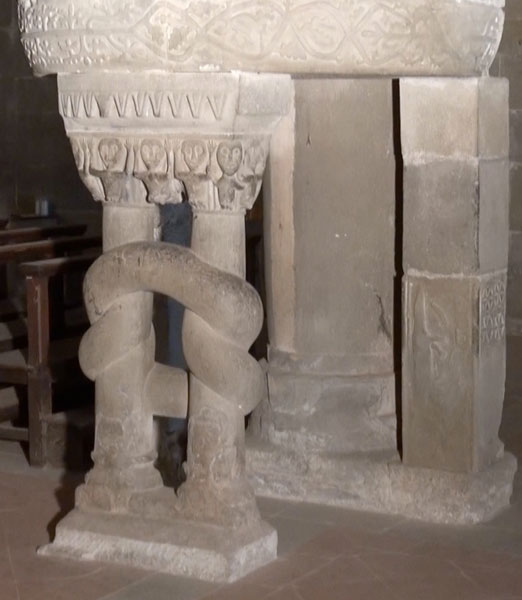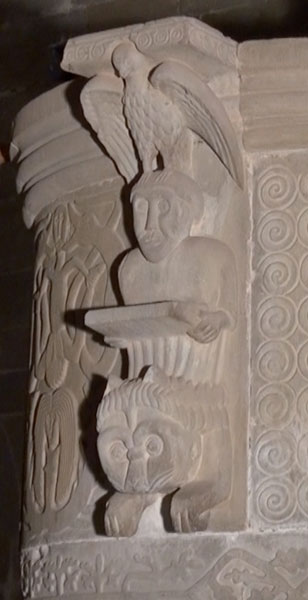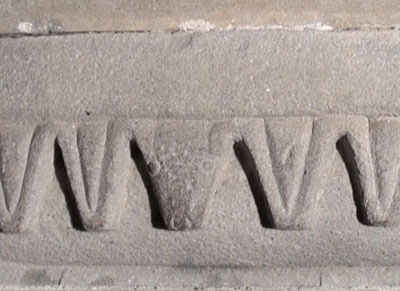THE BASE
As we have seen, the only original part of the base of the pulpit is the front. Two knotted columns sharing a capital with figures in bas-relief under a tall abacus rest on a small rectangular base. Such columns are called ofitiche in Italian from the Greek òphis (snake), and Gropina’s are among the earliest examples of this Romanesque motif most frequently found in northern Italy, Bavaria and Burgundy, practiced mainly by artists from Como and connected with the Cistercian order (founded in 1098). Knotted columns of four elements also exist, such as in the Duomo of Trento and in the cloister of the Abbey of Chiaravalle. Two pairs of knotted columns are found in the third stage of small columns on the façade of the Lucca cathedral (13th century). The symbolic meaning of these columns in this pulpit might be, as sustained by don Valente Moretti, who published his analysis of its interpretation (2004), the mystery of the Trinity: the Father and Son united by the Holy Spirit (the knot) and also the double nature of Christ, human and divine. The Trinity is therefore the origin and support of everything. The double capital shows twelve figures, interpreted as the twelve Apostles, kneeling in prayer on the Pentecost at the moment of receiving the Holy Spirit, symbolized by the small stylized triangular flames on the abacus; on the fourth triangle from the left the head of a bull appears as a symbol of Saint Luke, the only Evangelist who told of the descent of the Holy Spirit upon the disciples of Jesus, in the Acts of the Apostles.
Whether the second pieve of Gropina was built by the Lombards or after the passage to the Franks and to the Abbey of Nonantola, the stylistic elements of the pulpit are nevertheless very close to Lombardic taste: in the base this is evident in the figures of the Apostles, in very flat relief (almost a stiacciato) and with characteristically large oval heads and wide open eyes. The disproportion was intentional, because for the Lombards the head was the principal part of the body, and as for the Greeks, reality was thought to be perceived by means of rays emanating from the eyes and illuminating and revealing the world, the contrary of what actually happens (when reflected light rays strike the retina which transmits the image to the brain). A pair of knotted columns similar to those of the base are seen outside, on the back of the Romanesque apse.
The Evangelists and the dating
The bottom of the body of the pulpit contains a continuous sculpted band of oak branches: the oak is a Christian symbol representing constancy in faith and virtue, and also Christ himself as a force in adversity. In addition, the oak, together with the holly and the aspen, is one of the trees from which the Cross might have been made. Above this band there are five panels, also in bas-relief, and a bookstand supported by symbols of three of the evangelists, from bottom to top the lion of Mark, the angel of Matthew and the eagle of John. As we have already seen, the symbol which completes the tetramorph is the ox of Luke represented on the base. The tetramorph also has a symbolic meaning: the lion of Mark, represented here without wings, is the one who roars in the desert opening the way, and also the royal dignity of Christ; Matthew is symbolized by an angel or a winged man, the human nature of Jesus; the eagle of John is the ascension, the divine nature of Christ, because "the wings of an eagle fly to great heights", thus "it can watch the sun " (Saint Jerome); the eagle is often shown supporting a reading stand because he represents the inspiration of the Evangelists. The ox symbolizes sacrifice, atonement and the priesthood of Jesus, and it is often winged. But in Gropina this group hides a secret not known until recently: the date of the pulpit, engraved on the board that the angel of Matthew holds in his hands, mentioned by Repetti in 1835 and which Gino Manneschi tried to decipher in 1921. Finally in 1966 Carlo Fabbri published for the first time the photographs and a correct trasncription, thanks to his paleographic knowledge. According to his transcription the pulpit was commissioned by the priest Bernardo in 825. The transcription by Fabbri reads:
[...]Q[...] [PRESBIT]ERV(M) BERNARD(VM)
[...] M(ISE)R(I)CHORD(EM)
A(NNO) D(OMINICE) I(NCARNATIONIS)
DC[CC]XXV I.R.f(ecit).
This makes the pulpit one of the very few dated Lombard works, and even more important because Tuscany is not a “typically” Lombard zone, such as Friuli, with Cividale. In addition Fabbri recognized the inscription as belonging, for the style of some of its letters, to the scriptorium of the Abbey of Nonantola, to which Charlemagne and the duke Nordpert had assigned the Lombard pieve of Gropina around 780. The pulpit of Gropina seems to have inspired the group supporting the lectern in the Florentine church of San Miniato al Monte, begun in 1013 and finished in the 12th century.
Another very fragmentary inscription is found along the edge of the lectern, interpreted by Fabbri as LEX and IUS, divine law and judgment. Lastly, the bookstand is decorated by a spiral motif, which we find again in one of the panels.



